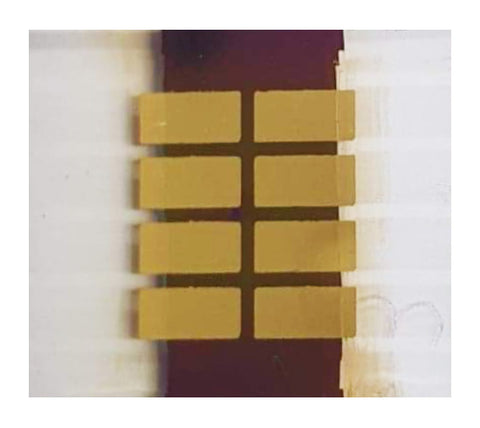What Are Perovskite Solar Cells?

A perovskite solar cell is a thin film photovoltaic device using a perovskite material as the active layer. In these devices, perovskites absorb sunlight and convert it into electrical energy. Certain perovskites have fundamental properties which make them excellent at this. In some ways, perovskites are even better than the materials used in current solar cells.
This means we could use perovskite solar cells in many interesting ways, and this is one of the reasons that they have caused a lot of excitement in the scientific community.

What is a Perovskite?
Broadly speaking, the term perovskite describes a material with a specific crystal structure. These crystals are naturally occurring in the form of calcium titanate, and have few practical uses. However, if you combine certain organic and inorganic materials in the same structure, you can create a perovskite semiconductor. It is these synthetic perovskites which can be used to make highly efficient solar cells.
One reason why perovskites have excited researchers so much is that perovskite solar cells have achieved impressive device efficiencies very quickly. In less than 15 years, the maximum efficiency of perovskite solar cells has risen from 3.9% to 25.7%. [ref NREL] For context, most solar panels you find today are crystalline silicon (c-Si) solar cells, and it took 37 years for C-Si solar cells to achieve comparable efficiencies.
Advantages of Perovskite Solar Cells
Silicon solar cells currently dominate the market, and have had a considerable head-start. However, perovskites have several exciting qualities which mean that they could be very useful when implementing different types of solar technology.
They can be flexible, lightweight, and even semi-transparent
Perovskites absorb visible light very efficiently as they are a direct band gap semiconductor. This means that high efficiency devices can be achieved with a very thin perovskite layer (often less than 1µm thickness).
Perovskite solar cells could potentially be used in situations where silicon solar cells are too heavy, thick, or rigid. For example, flexible PSC devices have been made on plastic substrates, semi-transparent PSCs devices have been used to shade windows while producing small amounts of electricity, and ultra-thin PSC modules have even been used to power a very tiny plane.
They could be cheaply and easily manufactured
Perovskite solar cells can be entirely solution processed. This means that they can be made with methods like slot die coating and ink jet printing, which are often used in large scale manufacturing. This could indicate they can be easily adapted for large area manufacturing. For the dreamers among us, we imagine factories printing solar modules at an extraordinary rate on massive rolls or even a future with paint-on or spray on solar cells. However, PSCs are still a long way from this yet. Additionally, perovskites solar cells can be created and deposited through other techniques, such as vacuum deposition and atomic layer deposition – so they are extremely adaptable materials.
Tandem Solar Cells
In a tandem solar cell, multiple solar devices are stacked on top of one another to increase the amount of electrical energy that we can gain from solar irradiance. Perovskites can more efficiently use smaller wavelengths of the sun’s spectrum, so the efficiency of a C-Si solar cell can be improved by depositing a perovskite solar cell on top! Perovskite-silicon tandem devices have achieved efficiencies of up to 31.3%, which is significantly higher than either C-Si or perovskite solar cells individually!
How Are Perovskite Solar Cells Made?
Perovskites have a similar structure to a lot of 3rd generation photovoltaic devices. The perovskite absorber material is placed between two electrodes. These electrodes are connected to an external circuit.
There are often layers between the perovskite and electrodes, which help draw out specific charges. This structure allows current to flow through the device. These layers on top of one another, and this stack is deposited on a substrate (often ITO coated glass, but sometimes other materials can be used).
Each layer needs different conditions in order to make a a smooth film. As mentioned before, most of these layers can be deposited using solution processing techniques. Researchers commonly use spin coaters to deposit perovskite layers. Yet, for research focusing on scaling up this process, slot die coating or blade coating methods are used instead.
The Future of Perovskite Solar Cells
Currently, perovskite solar cells are at the research stage of development. Although they have very high efficiencies, they still have some stability issues which need to be tackled before they hit the marketplace. Researchers also need to work out how to convert small area devices to large-area devices and modules without sacrificing efficiency.
However, there are a few companies currently working on commercialising perovskite solar cells, and there is huge scientific interest in this subject. There is plenty of scope for perovskite solar cells to be improved, optimised, and scaled in the not-too-distant future.
Perovskite Materials
